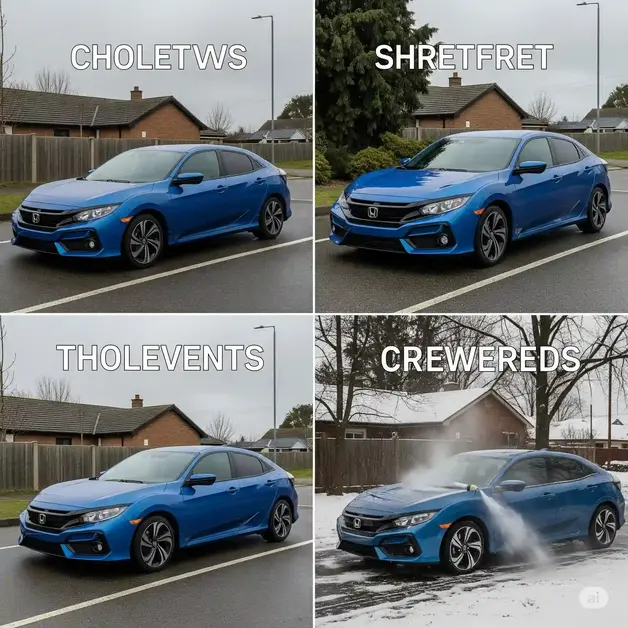Ever washed your car, only for it to rain the same afternoon? I’ve been there more times than I’d like to admit—wasting time, money, and effort, only to end up with streaks, spots, and pollen stuck all over again. That’s when I realized the timing matters just as much as the wash itself. Over the years, I’ve learned the hard way when not to wash and, thankfully, found the sweet spots for every season—from freezing winters to blistering summers. So, when is the best time to go to the car wash? Let’s talk about timing, temperature, and how to keep your ride looking its best no matter the weather.
When Is The Best Time To Go To The Car Wash
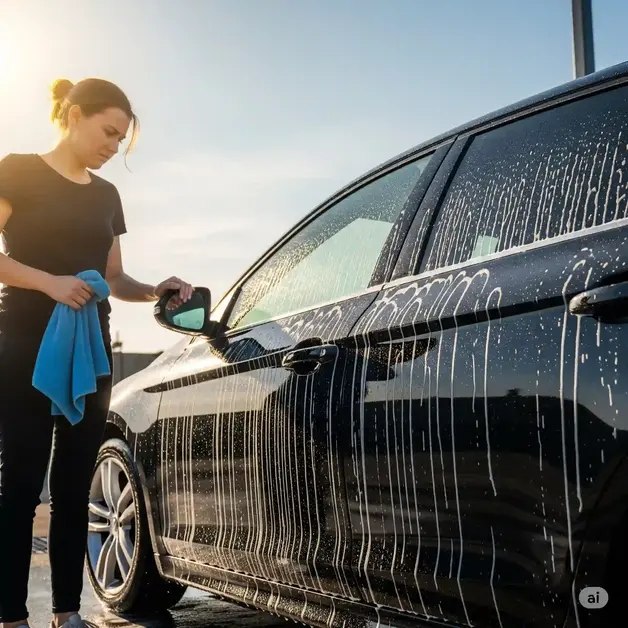
Here’s something I learned the hard way: washing your car at the wrong time can actually make it look worse. I used to think, “Hey, it’s sunny out—perfect day for a wash.” Spoiler alert: it wasn’t.
One summer afternoon, I decided to wash my car right after lunch. The sun was blazing, the pavement was hot enough to fry an egg, and I thought I’d be done in 20 minutes. Instead, the soap dried on the surface before I could rinse. Water spots formed instantly. And to top it off? A gust of wind blew dust onto the still-wet surface. That black car I was so proud of? Covered in blotches and grime again within an hour.
Short answer: Washing your car in the heat of the day often leads to water spots, soap streaks, and a finish that looks worse than before.
Timing isn’t just about looks, either. A badly timed wash can damage your paint over time. Pollen, for instance, isn’t just annoying—it’s acidic. If you don’t rinse it off properly, it can eat away at your clear coat. And don’t even get me started on winter road salt. Leave that stuff on too long and it starts rusting your undercarriage.
Short answer: Washing too late after salt or pollen exposure can lead to rust or paint damage.
I’ve also noticed that washing at the wrong time means you miss spots—literally. When the sun hits your windshield just right, it’s hard to see the grime properly. You end up thinking the car’s clean, but then drive into the shade and realize half the hood still looks dusty.
Short answer: Bright sunlight makes it harder to spot dirt, so you may miss cleaning key areas.
Over time, I’ve figured out that a well-timed car wash is less about the day and more about the conditions—light, temperature, and wind. When those align, your car not only looks cleaner but stays that way longer. It’s like giving your ride a proper spa day instead of a rushed shower.
Short answer: The right timing gives you better results and helps the clean last longer.
And let’s not forget one of the biggest reasons timing matters—resale value. A car with shiny paint and no visible rust just feels better, right? Buyers notice that. And if you’re like me and plan to keep your car for years, regular, well-timed washes can keep the body looking fresh and protected from wear.
Short answer: Smart wash timing helps preserve your car’s condition and boosts resale value.
Best Time of Day to Go to the Car Wash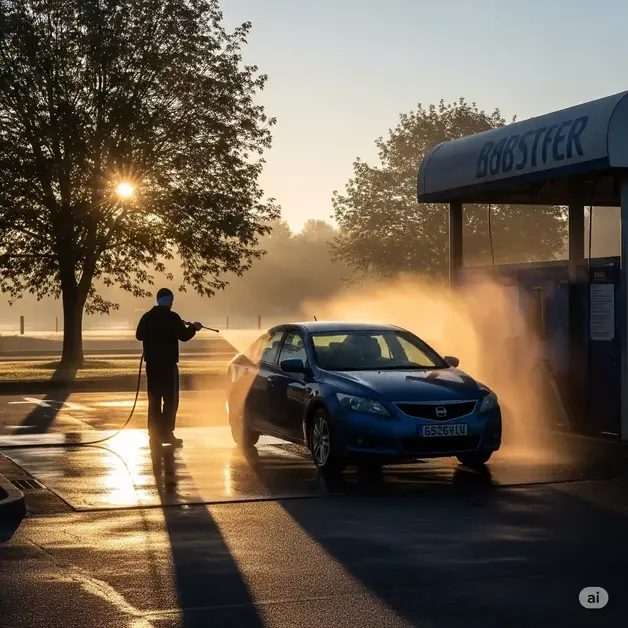
Let me say this straight up: not all hours are created equal when it comes to washing your car. I’ve tested them all—early mornings, scorching afternoons, late evenings—and yep, some were total flops. The time of day can make or break your car wash, literally. From streaks to soap stains, and even wasted money, timing changes everything.
Short answer: The best time to go to the car wash is early morning or late afternoon when the sun isn’t too strong and your car has time to dry gently.
Early Morning (Winner in Most Cases)
Hands down, early morning is my go-to. The air is cooler, the sun is softer, and your car isn’t baking hot from sitting in the sun all day. I’ve found that water evaporates more slowly in the morning, so soap doesn’t dry mid-scrub and leave spots.
It also feels like a fresh start. I usually roll in around 7:30 or 8 a.m., right before the crowd hits. The line is short, the staff are in a good mood, and the whole process is quick and easy. I even get better results with those touchless washes in the morning—no glare bouncing off the windshield while drying. Want to wash at home instead? A good touchless foam sprayer makes early morning washes quick and effective.
Short answer: Early morning gives you cooler temps, fewer crowds, and a cleaner finish with less streaking.
Late Afternoon or Early Evening
If mornings aren’t your thing (I get it—we’re not all morning people), late afternoon works too. I’m talking about that sweet spot between 4:30 and 6:00 p.m., when the sun starts to calm down and shadows get longer. Especially in hotter states like Arizona or Texas, this is when the pavement cools just enough.
But here’s a quick warning I learned the hard way: during pollen season, evenings can backfire. That fine yellow-green dust? It loves to float around just as the day cools down. One time I washed my car at 5 p.m., then parked under a tree. The next morning, it looked like a fuzzy tennis ball. So if you live in a pollen-heavy area, mornings are still safer.
Short answer: Late afternoon works well in hot areas, but skip it if pollen is in full swing.
Avoid Midday in Summer
Now, let me save you from the disaster I walked into more than once. Washing your car at noon during summer? Bad idea. The sun is at full strength, and it turns every drop of water into a problem. The soap dries too fast. The water leaves marks. The paint feels like it’s sizzling. One summer in Dallas, I made this mistake—and the soap actually baked onto my black SUV before I could rinse it. I spent the rest of the day wiping it down with vinegar just to get the white streaks off.
It’s not just the paint. Your windshield can crack from a sudden temp change if it’s been sitting in the sun and you blast cold water on it. So even if you’re in a rush—skip the midday wash. It’s just not worth the risk.
Short answer: Never wash your car midday in summer—soap dries too fast, water spots form quickly, and extreme heat can cause damage.
Best Time to Get a Car Wash in the Winter
Let’s be real—winter is brutal on cars. Salt, slush, grime… it all piles up fast. I used to think, “Why wash it now? It’s just going to get dirty again tomorrow.” But that thinking cost me. One winter, I ignored the build-up for weeks. When spring finally rolled around, I noticed rust spots starting to form near the wheel wells. That was my wake-up call.
Short answer: The best time to get a car wash in winter is midday, when the temperature is above freezing and the sun helps dry your car naturally.
Washing in freezing temps isn’t fun—and honestly, it can be risky. I once tried rinsing off salt when it was 25°F outside. Big mistake. The water froze to my doors, and I had to pour warm water just to open them. Lesson learned: check the weather first. If it’s below 32°F, wait it out. If it’s 35°F or higher and sunny? That’s your window.
Short answer: Always wash when it’s at least 35°F to avoid frozen doors, streaks, or damage.
Midday During Above-Freezing Temps
Around midday is your best bet. That’s when the sun is at its highest and the air has had time to warm up a little. In Ohio, where I live, winter days can be hit or miss. But if the forecast calls for a “warm” 38°F and some sun, I block out my lunch hour and head to the car wash. Midday warmth gives the water a chance to dry before it can freeze to the surface.
Short answer: Midday car washes let sunlight speed up drying time and reduce the risk of freezing.
And don’t skip it just because the snow’s not deep. Road salt sticks around long after the roads look clear. I’ve found that going once every 7 to 10 days in the winter keeps things in check. Especially after a snowstorm, I make it a habit to rinse everything down—especially the undercarriage. That’s where the worst salt buildup hides. Out of sight, but definitely not harmless.
Short answer: Wash your car every 7–10 days in winter, especially after snow or salt exposure.
If your local car wash has heated bays or drying blowers, that’s gold. For driveway winter washes, a heated portable pressure washer can save the day (and your fingers). I’ll drive a little out of my way to find one. A place with indoor lanes means I don’t have to worry about water freezing mid-dry. Heated drying also gets into tight spots where trapped moisture could turn into ice later.
Short answer: Choose a car wash with heated drying or indoor bays during winter for a safer, cleaner result.
So yes, winter car washes take a little more planning. But from my experience, they’re worth every minute. It’s not just about looks—it’s about protecting your investment. A little salt today can mean a lot of rust tomorrow. And when it comes to resale or just driving a car that still feels “new,” that extra effort really shows.
Short answer: A well-timed winter wash protects your paint, your undercarriage, and your peace of mind.
Best Time to Wash Your Car in Summer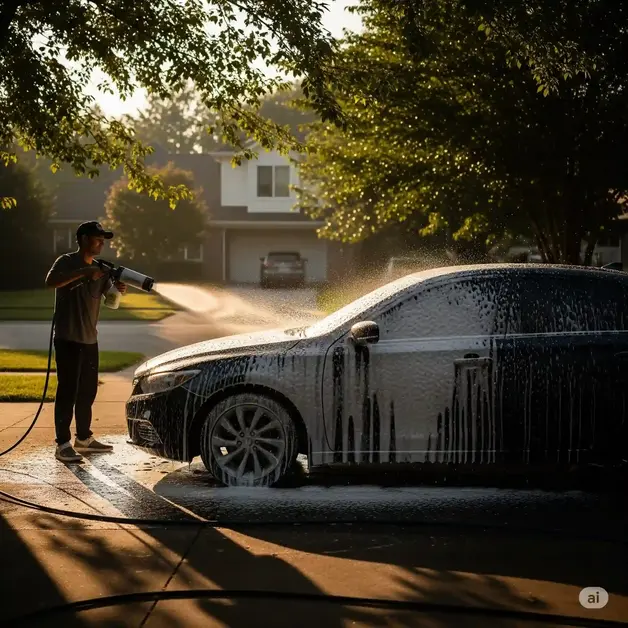
Summer sounds like the perfect time to wash your car, right? Sunshine, clear skies, and long days? Well… not exactly. I’ve learned the hard way that summer heat can ruin a good wash faster than you think. It’s all about timing—when you do it can make or break your results.
Short answer: The best time to wash your car in summer is early morning or shaded evening, when the sun isn’t too strong and your car won’t dry too fast.
Cloudy Mornings or Shaded Evenings
This is my sweet spot. Early in the morning—right after sunrise if I’m up—or just before the sun sets, that’s when I get the best results. The air’s cooler, my car’s surface isn’t blazing hot, and I don’t have to rush. On cloudy days? Even better. No direct sun means I can take my time without worrying about water spots or dried-up soap.
I’ve had mornings where I washed the car at 7 a.m., and it looked just as clean at dinner. When I used to do it at noon? By 2 p.m., it was covered in streaks and heat haze again.
Short answer: Wash your car when the sun is low—early morning or evening—for a smoother, streak-free clean.
Why Direct Sunlight Is Your Worst Enemy
Let me tell you about the time I thought I’d multitask at a car wash during a lunch break in Texas. Big mistake. The soap dried before I could rinse the roof. Water spots baked into the paint, and even after wiping it down twice, the hood still looked dusty. That black paint? It looked like a chalkboard.
The thing is, when your car’s hot, water and soap don’t sit—they evaporate instantly. That’s what causes those annoying spots and makes it harder to clean evenly.
Short answer: Direct sunlight heats up your car fast—causing soap to dry too quickly and leaving spots behind.
Pollen Alert: Daily Cleanup for Tree-Lined Neighborhoods
If you live in a place with lots of trees (like me), summer isn’t just about heat—it’s pollen season too. I once left my car under a maple tree for three days in June. When I came back, the windshield had a green layer thick enough to draw on. Even after washing it, the trim still looked dusty.
Now I’ve got a routine—if the pollen’s bad, I do a quick rinse every couple of days. It doesn’t take long, and it keeps the buildup from getting out of control. Also, I’ve learned to never park under trees in the summer unless I want nature’s version of confetti all over my hood.
Short answer: In high-pollen areas, wash more often and avoid tree cover to prevent build-up and staining.
Real Example: What Happened After Parking Under a Pine Tree for 3 Days
This one still makes me cringe. I parked at a friend’s cabin for the weekend. Beautiful spot—quiet, shaded, surrounded by pine trees. But by the time I left, my car was coated in sticky yellow powder and fine sap. The windshield wipers couldn’t clean it. Even the pressure washer had trouble with the resin on the hood.
That summer, I learned pine trees are some of the worst culprits. Their pollen clings tight, and the sap? Forget about it. I had to hand-scrub it with a bug and tar remover. Ever since then, I park in the open sun if I have to choose between that and a pine tree.
Short answer: Pine trees drop pollen and sap that are hard to clean—avoid parking under them, especially in summer.
If you time it right, a summer car wash can feel like therapy. There’s something calming about the rhythm of it—the water, the shine, the fresh look after it’s done. But get the timing wrong? You’re just fighting the weather. I’d rather enjoy it than rush to fix sun-baked mistakes.
Short answer: A well-timed summer wash gives you better results and makes the whole process way more enjoyable.
Best Temperature to Wash Your Car
If you’ve ever washed your car on a freezing morning or a blazing afternoon, you probably already know—temperature makes a big difference. It’s not just about comfort. It actually changes how clean your car gets and how long it stays that way.
Short answer: The best temperature to wash your car is between 50°F and 75°F, where it’s warm enough to dry gently but cool enough to prevent water spots and soap streaks.
Ideal Range: 50°F to 75°F
From my experience, this is the temperature range where everything just works. The water doesn’t freeze, the soap stays foamy, and your microfiber towel doesn’t turn stiff mid-dry. Around 60°F? That’s my personal favorite. The air feels fresh, the car cools evenly, and I’m not rushing to beat the sun or the frost.
Short answer: Washing your car at 50–75°F keeps everything manageable and gives you the cleanest, streak-free finish.
I’ve found that when the air’s in this sweet spot, I don’t even need to stress about shadows or wind. It’s forgiving—mistakes don’t turn into water spots right away, and your car actually stays clean longer. You can even let it air dry a little before finishing it off without worrying about spotting.
Why Extremes Are Bad for Your Finish
Now let me tell you about the extremes—both high and low temps can mess up a wash. When it’s below freezing, the water can freeze on your doors, your locks, even inside your side mirrors. I’ve had to pour warm water just to get my car doors open after a cold-day wash gone wrong. Once, my wipers froze solid before I could even squeegee the windshield. Never again.
On the flip side, in super hot weather—think above 90°F—soap dries faster than you can rinse it. Even if you’re quick, the sun bakes everything instantly. I’ve seen it turn streaks into stubborn stains that don’t come off without vinegar or polish. Your paint literally feels like a hotplate. It’s like trying to wash a frying pan while it’s still on the stove.
Short answer: Avoid washing your car below 32°F or above 90°F—both can cause streaks, frozen parts, or damage.
Tip: Use Touchless or Indoor Wash in Harsh Weather
If the weather’s against you—too cold, too hot, or just plain unpredictable—go touchless or find an indoor bay. I’ve driven a few extra miles just to reach a place with heated facilities during winter. Totally worth it. Not only does it keep the water from freezing, but the warm air dry at the end gives your undercarriage and trim a break from winter grime buildup.
In summer, I like to use touchless washes when it’s hot outside and I can’t time the shade. No sponges, no foam pads—just high-pressure water and soap that gets it done quickly without scorching my paint. Plus, those blow dryers actually help stop water spots before they start.
Short answer: Use a touchless or indoor wash when weather conditions are too harsh for a safe and effective DIY wash.
Mini Case: What I Learned Washing My Car in Freezing Temps
One January morning, I decided to be “productive” and wash the salt off my car. It was about 28°F, but I thought, “I’ll be fast.” Nope. The moment I sprayed water, it turned into slush. My door handles froze shut. The side mirror had an icicle. And the worst part? The wet road on the way home just undid everything.
I spent more time fixing the mess than washing the car. Lesson learned: if it’s not above 35°F with some sun, don’t even bother. Just wait a day or hit a heated wash.
Short answer: Don’t wash your car below freezing—water can freeze mid-wash and cause more trouble than it’s worth.
In short, temperature matters just as much as technique. Whether you’re hand-washing in your driveway or using an automatic bay, choosing the right temp makes the whole process smoother and safer. I always check the weather before grabbing a hose. Trust me—washing your car in the right conditions saves time, energy, and your paint job.
Short answer: Check the forecast and wash your car between 50°F and 75°F for the best results—no streaks, no stress.
How Often Should You Wash Your Car?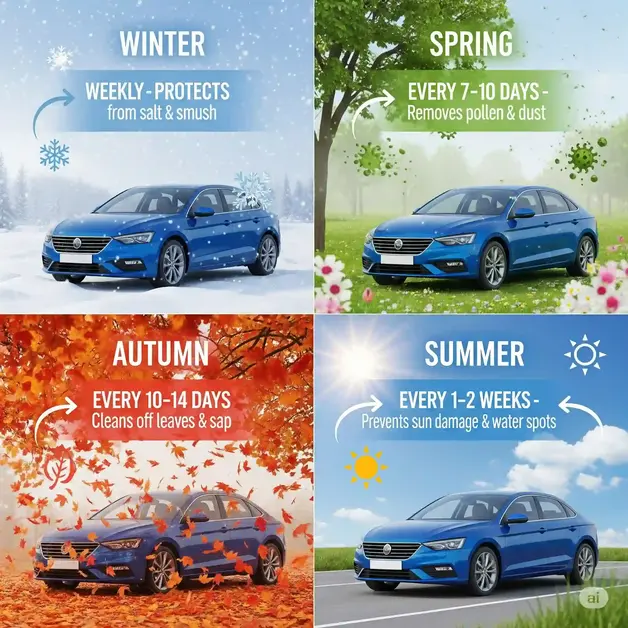
Let’s be real — most of us don’t wash our cars as often as we should. I used to think once a month was good enough. But over time, I realized it’s not just about keeping it shiny. It’s about protecting your car’s paint, resale value, and even your own mood. A clean car just feels better, doesn’t it?
Short answer: You should wash your car at least once every two weeks, and more often in harsh weather or after long drives.
It Depends on Where You Live
If you live in a city with lots of traffic and pollution, your car collects grime fast. I noticed this when I moved to a metro area — the layer of black dust on my white car was almost embarrassing within days. On the other hand, when I visited a quiet coastal town, my car stayed cleaner for longer, but salt from the air meant I still had to rinse it often.
Short answer: Urban and coastal areas require more frequent washes due to grime, smog, and salt exposure.
Seasons Change Everything
Winter is the sneakiest car killer. Road salt sticks to everything, including your undercarriage. I once skipped washing my car for a few weeks in December, and by January, I spotted small rust patches. Ever since, I’ve been washing it every 7 to 10 days in winter — no excuses.
In summer, it’s more about pollen, dust, and bird droppings. If you park under trees like I do (free shade, right?), you’ll want to rinse it weekly — sometimes even more.
Short answer: Wash weekly in summer and at least every 7–10 days in winter to avoid damage from salt and grime.
After Rain or Long Drives? Definitely Yes
Rain seems like nature’s free car wash, but it’s not. I learned the hard way that rainwater can leave behind water spots and even acid residue, especially after a dusty day. After every good downpour, I do a quick rinse and dry, especially if I had just washed it the day before.
Same goes for long drives. Bugs on the bumper, road tar on the sides — the faster you clean them off, the easier it is.
Short answer: Always wash after heavy rain or long road trips to prevent stains and damage.
Your Driving Habits Matter
Are you commuting daily on busy roads? Or does your car mostly chill in the garage? I used to drive 40 miles a day through a dusty construction zone. My wash schedule was basically once a week, no questions asked. Now, I work from home and drive less — so every two weeks works fine for me.
Short answer: Daily drivers need weekly washes; occasional drivers can wait 2–3 weeks.
A Simple Seasonal Schedule That Works
Here’s a personal routine I’ve settled on that you might find helpful:
- Winter: Every 7–10 days (focus on undercarriage)
- Spring: Weekly (thanks, pollen!)
- Summer: Weekly or after storms/tree sap
- Fall: Biweekly unless leaves or dust pile up
This schedule has kept my car looking sharp and, more importantly, kept small issues like rust or dull paint at bay.
Short answer: Adjust your car wash frequency by season — more often in winter and spring, less in mild fall weather.
Tips for a More Effective Car Wash (Any Time of Year)
Let’s be real—nobody wants to spend time washing their car only to see spots, streaks, or dirt reappear the next day. I’ve made that mistake more times than I care to admit. Over the years, I’ve picked up a few simple habits that make a big difference—whether it’s winter, summer, or somewhere in between.
Always Check the Weather First
This might sound obvious, but I’ve been burned here before—literally and figuratively. I once gave my car a perfect wash on a sunny Sunday afternoon… and it rained 10 hours later. Total waste.
Short answer: Always check for rain or dust storms within the next 12–24 hours before washing your car. A quick look at the forecast can save your time and your shine.
If it’s windy or humid, hold off. Wind kicks up dirt, and humidity makes drying take forever. A clear, calm day is your best bet.
Avoid Washing on Windy or Dusty Days
Have you ever dried your car and looked back only to see a fine layer of grit settling on it? That happened to me when I washed during a breezy afternoon. The worst part? That grit can actually scratch your paint if you wipe it off dry.
Short answer: Wind stirs up dust that clings to wet paint, so wash on calm days for better results and less risk of scratching.
It’s especially important if you live near construction sites or dusty roads. Trust me, you don’t want that sandpaper feeling on your clear coat.
Rinse More Than You Think You Need To
This tip changed everything for me. I used to do a quick rinse, soap up the car, rinse again, and call it done. But I always ended up with weird smears or leftover dirt.
Short answer: Rinse thoroughly before and after washing to avoid grinding dirt into the paint and to prevent soap spots.
Now I give my car a good rinse—like a full minute per panel—before the soap even touches it. A solid hose nozzle with multiple spray settings makes pre-rinsing and final rinses easier—especially for loosening stuck-on dirt. It softens dirt, cools the surface, and helps loosen grime. After washing, I rinse again until I see nothing but clear water running off.
Dry With a Microfiber, Not a Towel
Don’t use your old bath towel—I used to, and it left lint everywhere and tiny scratches I couldn’t explain at first. Microfiber cloths are a game-changer. I personally keep a pack of these premium microfiber towels in my trunk—they’re streak-free and safe on paint. They’re soft, absorbent, and don’t leave streaks.
Short answer: Use microfiber cloths to dry your car for a spot-free finish and to avoid scratching the paint.
Even better, use a few. Start with one for the windows, one for the body, and one for detailing the trim. That way, you’re not dragging dirt across sensitive areas.
Choose a Car Wash With the Right Features
If you go to a professional car wash, pay attention to what they offer. Some places skip the undercarriage wash, and that’s a big no-no in winter. If you’re washing at home, consider an undercarriage cleaner attachment. It connects right to your hose and helps rinse off salt and grime easily. Salt buildup underneath can lead to rust—and trust me, fixing that isn’t cheap.
Short answer: Look for car washes that offer undercarriage cleaning, spot-free rinses, and proper drying equipment.
In summer, make sure the wash has shaded bays or fast drying. And year-round, that spot-free rinse makes a world of difference. No more chasing water spots around your car with a rag.
FAQs – Quick Answers to Common Questions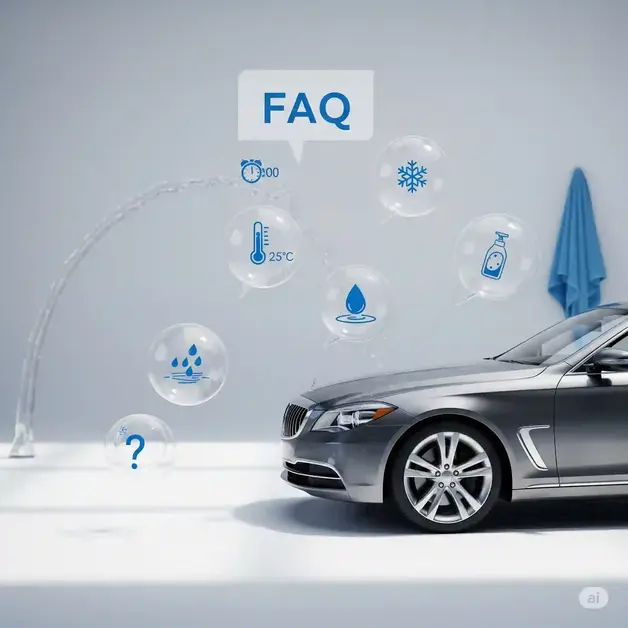
What is the best time of day to get your car washed?
The best time to go to the car wash is early morning or late afternoon on a cool, dry day. This helps avoid soap spots, sun glare, and long lines.
How often should I wash my car in winter?
Wash your car every 7 to 10 days in winter, or right after driving on salty or slushy roads. This stops rust and keeps the paint safe.
Can I wash my car in cold weather?
Yes, but only if it’s above 32°F (0°C). Dry it fully after to stop water from freezing on the paint or locks.
Is rain bad after a car wash?
Rain can leave water spots and dust behind. If your car has wax or sealant, the rain won’t do much harm.
What’s the worst time to wash a car?
Midday in summer is the worst time to wash your car. The sun dries soap and water too fast, leaving streaks and spots.
What’s the best temperature to wash a car?
The best temperature to wash your car is between 50°F and 75°F. It’s warm enough to clean well and cool enough to avoid streaks.
How often should I wash my car in summer?
Wash your car once a week or more often if there’s pollen, dust, or bird droppings. Shade and cool days are best.
Is it okay to use an automatic car wash in winter?
Yes. Choose one with heated bays and an undercarriage rinse to fight road salt and winter grime.
Should I dry my car after a wash?
Yes. Always dry your car with a clean microfiber cloth. This stops water spots and protects your car’s paint.
Does washing your car really help protect it?
Yes. Regular washing removes dirt, salt, and bugs that can damage paint, trim, and metal parts over time.
Final Thought
If you’re serious about keeping your car looking great and avoiding long-term paint damage, timing your car washes right is more than just a small detail—it’s a smart habit. But even if you’re the “only wash it when it’s dirty” type, knowing when not to wash (like in harsh sun or freezing temps) can save you headaches. I’ve learned the hard way—streaks, spots, and soap stains taught me what really works. Now, I treat every car wash as a chance to protect my investment, not just clean off the dirt. If you’re just getting started or want to upgrade your wash kit, check out my favorite car wash essentials on Amazon. Everything I use is there—from foam cannons to microfiber cloths.

